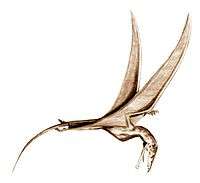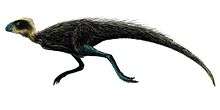Thecodontosaurus
| Thecodontosaurus Temporal range: Late Triassic-Early Jurassic,[1] 203.6–199.6 Ma | |
|---|---|
 | |
| Skeletal restoration | |
| Scientific classification | |
| Kingdom: | Animalia |
| Phylum: | Chordata |
| Class: | Reptilia |
| Clade: | Dinosauria |
| Order: | Saurischia |
| Suborder: | †Sauropodomorpha |
| Family: | †Thecodontosauridae Lydekker, 1890 |
| Genus: | †Thecodontosaurus Riley & Stuchbury, 1836 |
| Type species | |
| †Thecodontosaurus antiquus Morris, 1843 | |
| Synonyms[2] | |
|
Agrosaurus Seeley, 1891 | |
Thecodontosaurus ("socket-tooth lizard") is a genus of herbivorous basal sauropodomorph dinosaur that lived during the late Triassic period (Rhaetian age).
Its remains are known mostly from Triassic "fissure fillings" in South England. Thecodontosaurus was a small bipedal animal, about 2 m (6.5 ft) long. It is one of the first dinosaurs that were discovered and one of the oldest that existed. Many species have been named in the genus, but only the type species Thecodontosaurus antiquus is seen as valid today.
Discovery and naming
Thecodontosaurus antiquus
In the autumn of 1834, the surgeon Henry Riley (1797–1848)[3] and the curator of the Bristol Institution, Samuel Stutchbury, began to excavate "saurian remains" at the quarry of Durdham Down, at Clifton, presently a part of Bristol. In 1834 and 1835, they briefly reported on the finds.[4] They provided their initial description in 1836, naming a new genus: Thecodontosaurus. The name is derived from Greek θήκή, thēkē, "socket", and οδους, odous, "tooth", a reference to the fact that the roots of the teeth were not fused with the jaw bone, as in present lizards, but positioned in separate tooth sockets.[5] Thecodontosaurus was the fifth dinosaur named, after Megalosaurus, Iguanodon, Streptospondylus and Hylaeosaurus, though Riley and Stutchbury were not aware of this, the very concept Dinosauria only being created in 1842. In 1843 John Morris in his catalogue of British fossils provides a complete species name: Thecodontosaurus antiquus.[6] The specific epithet, "antiquus", means "ancient" in Latin.
The original type specimen or holotype of Thecodontosaurus, BCM 1, a lower jaw, fell victim to heavy World War II bombings by the Germans. Many remains of this dinosaur and other material related to it were destroyed in November 1940 during the Bristol Blitz. However, most bones were salvaged: 184 are today part of the collection of the Bristol City Museum and Art Gallery. Also, later some more remains were found near Bristol at Tytherington. At present, about 245 fragmentary specimens are known, representing numerous individuals. In 1985, Peter Galton designated another lower jaw, a right dentary, as the neotype, BCM 2. The remains had been found in chalkstone infillings, breccia deposited in fissures in older rocks. The age of these deposits was once estimated as old as the late Carnian, but recent studies indicate that they date from the Rhaetian.
Other species
Apart from the original type species, Thecodontosaurus antiquus, Riley and Stutchbury also found some teeth of carnivorous phytosaurians that they named Paleosaurus cylindrodon and P. platyodon. In the late nineteenth century, the theory became popular that such remains would have belonged to carnivorous prosauropods: animals with the body of Thecodontosaurus, but with heads armed with slicing teeth. In 1890, Arthur Smith Woodward accordingly named a Thecodontosaurus platyodon,[7] in 1908 Friedrich von Huene a Thecodontosaurus cylindrodon.[8] Though still defended by Michael Cooper in 1981, the hypothesis that such creatures existed has now been totally discredited.
On one occasion, material of Thecodontosaurus was by mistake described as a separate genus. In 1891, Harry Govier Seeley named Agrosaurus macgillivrayi, assuming the remains had been collected in 1844 by the crew of HMS Fly on the northeast coast of Australia.[9] It was long considered the first dinosaur found in Australia, but in 1999 it transpired that the bones probably belonged to a lot sent by Riley and Stutchbury to the British Museum of Natural History and then mislabelled. In 1906, von Huene had already noted the close resemblance and renamed the species Thecodontosaurus macgillivrayi. It is thus a junior synonym of Thecodontosaurus antiquus.[10]
Presently, the only valid species is thus T. antiquus.
Misassigned species
- Thecodontosaurus latespinatus von Huene, 1907-08 = Tanystropheus
- Thecodontosaurus primus von Huene, 1907-1908 = Protanystropheus
- Thecodontosaurus elizae Sauvage 1907
- Thecodontosaurus gibbidens Cope 1878 = Galtonia
- Thecodontosaurus skirtopodus (Seeley 1894) = Hortalotarsus
- Thecodontosaurus polyzelus (Hitchcock 1865) von Huene 1906
- Thecodontosaurus hermannianus von Huene 1908
- Thecodontosaurus diagnosticus Fraas 1912 = Efraasia
- Thecodontosaurus minor Haughton 1918
- Thecodontosaurus dubius Haughton 1924[11]
- Thecodontosaurus browni (Seeley 1895) von Huene 1932
- Thecodontosaurus alophos Haughton 1932 = Nyasasaurus[12][13]
Thecodontosaurus caducus was named by Adam Yates in 2003 for a juvenile specimen found in Wales;[14] in 2007 this was made the separate genus Pantydraco.[15]
Description

From the fragmentary remains of Thecodontosaurus, most of the skeleton can be reconstructed, the main exception being the front of the skull. Thecodontosaurus had a rather short neck supporting a fairly large skull with large eyes. Its jaws contained many small- to medium-sized, serrated, leaf-shaped teeth. This dinosaur's hands and feet each had five digits, and the hands were long and rather narrow, with an extended claw on each. This dinosaur's front limbs were much shorter than the legs, and its tail was much longer than the head, neck and body put together. On average, it was 1.2 metres (3.9 ft) long, 30 centimetres (12 in) or 1 ft. tall, and weighed 11 kilograms (24 lb). The largest individuals had an estimated length of 2.5 metres (8.2 ft).
In 2000, Michael Benton noted the existence of a robust morph in the population, seen by him as a possible second species or, more likely, an instance of sexual dimorphism. Benton also indicated some unique derived traits, or autapomorphies, for the species: a long basipterygoid process on the braincase; a dentary that is short in relation to the total length of the lower jaw; an ilium that has a back end that is subquadrate instead of rounded.[2]
The small size has been explained as an instance of insular dwarfism.[16]
Phylogeny
Riley and Stutchbury originally saw Thecodontosaurus as a member of the Squamata, the group containing lizards and snakes. This did not change when Richard Owen coined the term Dinosauria in 1842, because Owen did not recognise Thecodontosaurus as a dinosaur; in 1865, he assigned it to the Thecodontia. It was not until 1870 that Thomas Huxley became the first person to understand that it was a dinosaur, though referring it incorrectly to the Scelidosauridae.[17] Later, it would usually be placed in either the Anchisauridae or its own Thecodontosauridae.
Modern exact cladistic analyses have not been conclusive. Although not actually the earliest member of the group, Thecodontosaurus is sometimes placed in a very basal position among the sauropodomorph dinosaurs. It was earlier included under the Prosauropoda,[18] but more recently it has been suggested that Thecodontosaurus and its relatives preceded the prosauropod-sauropod split.[19] New reconstructions show that its neck is proportionally shorter than those in more advanced early sauropodomorphs.
The Bristol Dinosaur Project

Thecodontosaurus has formed the basis of a massive public engagement exercise, the Bristol Dinosaur Project, that has run since 2000. In 2009, HLF core funded the Bristol Dinosaur Project, which allowed for the hiring of an Educational Officer and a Fossil Preparator to further develop the project. This funding resulted in 3,5 years of extensive laboratory, research and outreach work that presented the project to thousands of people all around the world.
Notes
- ↑ Holtz, Thomas R. Jr. (2012) Dinosaurs: The Most Complete, Up-to-Date Encyclopedia for Dinosaur Lovers of All Ages, Winter 2011 Appendix.
- 1 2 M.J. Benton, L. Juul, G.W. Storrs and P.M. Galton, 2000, "Anatomy and systematics of the prosauropod dinosaur Thecodontosaurus antiquus from the upper Triassic of southwest England", Journal of Vertebrate Paleontology 20(1): 77-108
- ↑ Adrian Desmond (15 April 1992). The Politics of Evolution: Morphology, Medicine, and Reform in Radical London. Chicago: University of Chicago Press. p. 427. ISBN 978-0-226-14374-3.
- ↑ Anonymous, 1835, "Discovery of Saurian Bones in the Magnesian Conglomerate near Bristol", American Journal of Science and Arts 28: 389
- ↑ Riley, H., and S. Stutchbury, 1836, "A description of various fossil remains of three distinct saurian animals discovered in the autumn of 1834, in the Magnesian Conglomerate on Durdham Down, near Bristol", Proceedings of the Geological Society of London 2:397–399
- ↑ Morris, J., 1843, A Catalogue of British Fossils. British Museum, London, 222 pp
- ↑ A.S. Woodward and C.D. Sherborn, 1890, A Catalogue of British Fossil Vertebrat Dulao & Company, London pp. 396
- ↑ F. v. Huene, 1908, "On phytosaurian remains from the Magnesian Conglomerate of Bristol (Rileya platyodon)", Annals and Magazine of Natural History, series 8 1: 228-230
- ↑ Seeley, H.G., 1891, "On Agrosaurus macgillivrayi, a saurischian reptile from the northeast coast of Australia", Quarterly Journal of the Geological Society of London 47: 164–165
- ↑ Vickers-Rich, P., Rich, T.H., McNamara, G.C. & Milner, A. (1999). "Agrosaurus: Australia's oldest dinosaur?". Records of the Western Australian Museum Supplement 57: 191-200
- ↑ Haughton, S.H., 1924, "The fauna and stratigraphy of the Stormberg Series", Annals of the South African Museum 12: 323–497
- ↑ S.H. Haughton, 1932, "On a collection of Karroo vertebrates from Tanganyika Territory", Quarterly Journal of the Geological Society of London 88(4): 634-671
- ↑ Nesbitt, S. J.; Barrett, P. M.; Werning, S.; Sidor, C. A.; Charig, A. J. (2013). "The oldest dinosaur? A Middle Triassic dinosauriform from Tanzania". Biol. Lett. doi:10.1098/rsbl.2012.0949.
- ↑ Yates, A. M. (2003). "A new species of the primitive dinosaur Thecodontosaurus (Saurischia: Sauropodomorpha) and its implications for the systematics of early dinosaurs". Journal of Systematic Palaeontology 1(1): 1-42
- ↑ Galton, P.M., Yates, A.M., & Kermack, D. (2007). "Pantydraco n. gen. for Thecodontosaurus caducus Yates, 2003, a basal sauropodomorph dinosaur from the Upper Triassic or Lower Jurassic of South Wales, UK". Neues Jahrbuch für Geologie und Paläontologie, Abh., 243: 119-125
- ↑ Whiteside, D.I. and Marshall, J.E.A. (2008) "The age, fauna and palaeoenvironment of the Late Triassic fissure deposits of Tytherington, South Gloucestershire, UK". Geological Magazine, 14(1): 105-147
- ↑ Huxley, T. H. 1870. "On the classification of the Dinosauria, with observations on the Dinosauria of the Trias". Quarterly Journal of the Geological Society of London 26: 32–50
- ↑ Upchurch, P. (1998). "The phylogenetic relationships of sauropod dinosaurs". Zool. J. Linnean Soc. 124: 43–103
- ↑ Yates, A.M. & Kitching, J. W. (2003). "The earliest known sauropod dinosaur and the first steps towards sauropod locomotion". Proc. R. Soc. Lond.: B Biol Sci. 2003 Aug 22; 270(1525): 1753–8
References
- Moody, Richard. Dinofile. Pg. 23. Octopus Publishing Group Ltd., 2006
External links
| Wikispecies has information related to: Thecodontosaurus |



